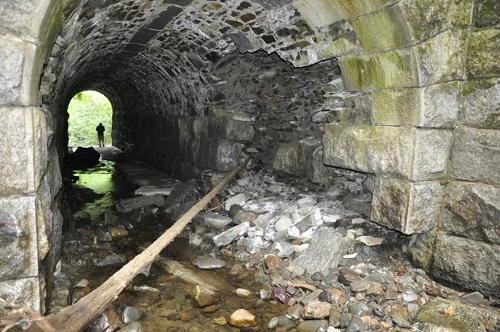 Sunday, September 29, 2024
Sunday, September 29, 2024  Sunday, September 29, 2024
Sunday, September 29, 2024 
Amateur historian Tammey McLean walked into the woods in Pembroke, near Woodstock, in search of a large stone structure from the last half of the 1800s.
This was her second attempt to find what she thought was a train tunnel. But this time, she was prepared: McLean was wearing boots and her 18-year-old son Kolby Cronkhite was with her in case she crossed paths with a bear or a moose.
As instructed by a man who had posted a photo of the “tunnel” on her Woodstock history Facebook page, a railway crossing would appear on the road, she was to park her car nearby, and follow a trail about 30 metres in.
In less than three minutes, she found herself in front of a towering stone arch built around 1870.
It was a culvert about 5½ metres tall and made of finished granite stones that fit perfectly together like puzzle pieces.
The stones near the curve had been cut in angles to form the arch, and it was easy to tell how painstaking the process must have been.
Surrounded by trees and plants, the arch culvert looked as if it belonged in an enchanted forest.
“What we saw first was a stream, and I could see the big cement boulders that were the outside of it. It was quite amazing to see,” said McLean.
Except it was falling apart.
The arch culvert was part of the Gibson branch railway, called the New Brunswick Land and Railway Company, according to Paul Hanson, a retired civil servant who is a railway fanatic.
“It is not a tunnel,” said Hanson. “It looks like a tunnel. But it is an arch culvert, a waterway. And any civil engineer would say it looks like a tunnel.”
Built by New Brunswick industrialist Alexander (Boss) Gibson, who owned sawmills and a cotton mill in Marysville, the railway line that passed above the arch culvert would haul coal and flour, sugar, molasses and other survival supplies as well as construction tools such as nails and spikes.
The Canadian Pacific Railway eventually bought the Gibson line and countless others in New Brunswick, then abandoned them around Jan. 1, 1995, as the company abandoned the East Coast.
As happened along other old railway beds in New Brunswick, the tracks above the culvert were pulled up and replaced by a trail. Today, it carries hikers as well as ATV and snowmobile riders, most oblivious to the beautiful structure coming apart beneath them.
Construction Links Network – the peer-to-peer content sharing platform for the construction, building and design community